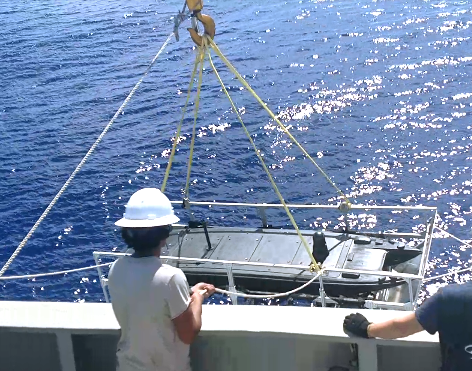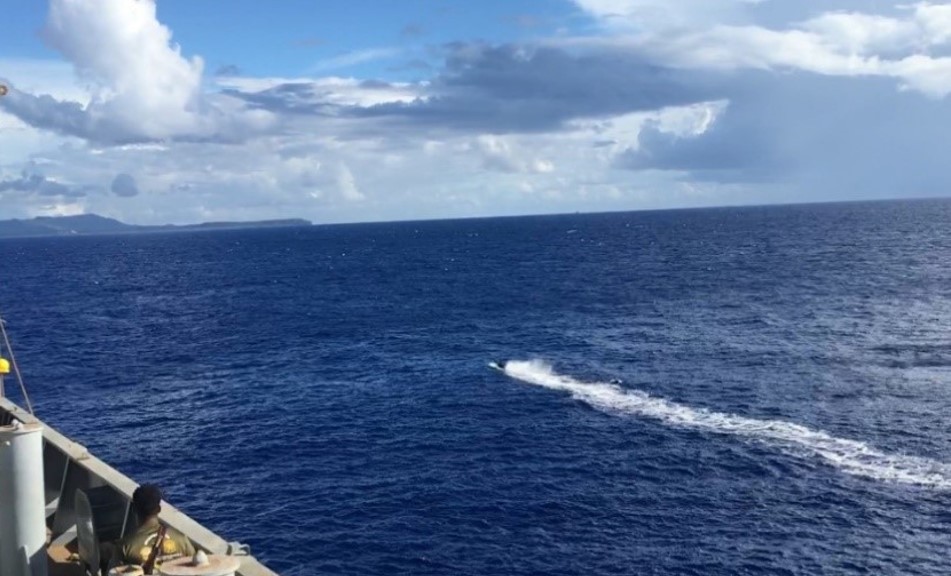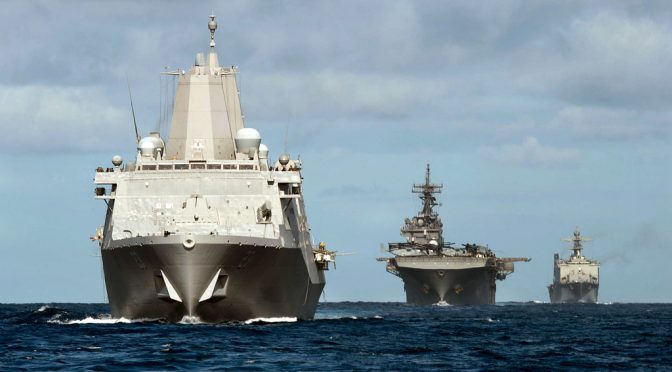Unmanned Maritime Systems Topic Week
By Neil Zerbe
Introduction
After almost two decades of languishing in near-obscurity while U.S. Marine Corps forces were engaged in ground wars in Iraq and Afghanistan, the U.S. Navy and Marine Corps amphibious assault force is experiencing a revival. The reason is clear: this warfighting formation is the one that is most vital in a wide-array of missions across the globe and across the spectrum of conflict. This has been true throughout this history of the Navy-Marine Corps team, and is perhaps more true today as the United States faces a new spectrum of threats from peer-competitors, to unstable rogue states, to the threat of global terrorism.
While today’s Navy-Marine Corps amphibious assault force is unlikely to conduct a major, brigade-level amphibious offensive involving thousands of troops, the ability to put a substantial number of Marines and gear ashore in response to terrorist activity, a natural disaster, or to deliver credible combat power for a higher-end fight is something the U.S. military must be prepared to do. Indeed, as the Director of National Intelligence capstone publication, Global Trends: Paradox of Progress, notes, “The chance of conflict in the next five years has never been higher.”1 U.S. Marines will likely be in any conflict engaged in by this nation.
Most people – and even many naval professionals – have only a rudimentary understanding of the complexities of amphibious operations. Unlike armies that move supplies over land with an armada of trucks and other vehicles, everything that Marines need when they land on the beach must travel with them in a variety of amphibious assault vehicles and landing craft, often in the face of well-entrenched enemy fire.
But that is only half the story. Once the Marines – who are equipped with only what they can carry in their pack – are on the beach and in the fight, everything they need to keep fighting must be delivered to them from the amphibious assault ships standing offshore. This includes ammunition (and lots of it), food, water, medical support, fuel for vehicles, and every other item imaginable.
The name for this resupply effort is logistics. This military art has been a mainstay of warfare for millennia. As Alexander the Great famously said, “My logisticians are a humorless lot…they know if my campaign fails, they are the first ones I will slay.” Over 2,300 years later, logistics is still vital to any military operation, and of all the U.S. military services, the U.S. Marine Corps is the one that is defining and refining this art.
The Navy-Marine Corps Team: Leading the Way in the Military Art of Logistics
Almost four decades ago, General Robert Barrow, USMC, Commandant of the U.S. Marine Corps, coined a phrase that is still a staple of U.S. War College curricula, “Amateurs talk about tactics, but professionals study logistics.” Today, that emphasis on logistics is ingrained in U.S. Marine Corps DNA. As Brigadier General Arthur Pasagian, USMC, Commander, Marine Corps Systems Command, noted at a recent symposium, “Logistics is a key enabler for all we do.”2 The Marine Corps has refined this logistics ability to a fine art and is seeking new technology to enable it to better perform this mission.
Partnering with the U.S. Marine Corps in delivering capability from the sea, the U.S. Navy provides the ships and the craft to bring logistics supplies ashore to support Marines on the beach. This teamwork was emphasized in the U.S. Navy’s strategic guidance, Design for Maintaining Maritime Superiority 2.0 (Design 2.0) which calls for, “Deepening integration with our natural partner, the U.S. Marine Corps.”3
The Navy-Marine Corps team has risen to this challenge by being proactive in exploring new technologies to increase the lethality of the nation’s amphibious assault forces in a series of exercises, experiments, and demonstrations. During the author’s years on a numbered fleet warfighter’s staff, he had the opportunity to observe a number of carrier strike group and expeditionary strike group exercises. These included a recent exercise, the INDOPACOM Joint Exercise Valiant Shield 2018, overseen by Commander Marine Forces Pacific (MARFORPAC) and conducted on the Marianas Island Range Complex as well as on the island of Guam, where new logistics concepts were explored.
Valiant Shield: Leveraging New Technology to Support Marines on the Beach
While recent exercises such as Bold Alligator and a series of Advanced Naval Technology Exercise (ANTX) events have looked at a wide range of technologies that could make expeditionary assault forces more lethal, agile, and survivable, others have looked at more discrete missions conducted by the Navy-Marine Corps team. Valiant Shield 2018 looked to use emerging technology – often off-the-shelf equipment – to support Marines on the beachhead during this critical juncture of any amphibious assault. To this end, a significant part of this exercise focused on logistics.
While many functions are important in an amphibious assault, once the assault is underway and Marines are on the beach, logistics is the critical factor in ensuring their success. The operation will often only succeed if the Marines are able to have rapid, reliable, and continuous resupply. Using manned naval craft to do this puts operators and vessels at unnecessary risk. Furthermore, using scarce manned craft to perform this mission takes them away from more vital roles. That is why this major Navy-Marine Corps amphibious exercise evaluated the ability of unmanned surface vehicles to conduct this resupply mission.
During Valiant Shield 2018, MARFORPAC demonstrated the ability to have unmanned surface vehicles resupply the landing force. The amphibious force commander used a 12-foot MANTAS USV to provide rapid ship-to-shore logistics resupply. While this small, remotely operated, USV carried only one hundred and twenty pounds of cargo; the proof-of-concept worked and successfully demonstrated that unmanned surface vehicles could safely and effectively resupply Marines ashore.
Using unmanned vehicles, either controlled by operators or programmed to follow a prescribed course, could be a game-changer for amphibious assault forces. Beyond taking operators out of harm’s way, using USVs for this mission frees manned craft for other missions. Additionally, having a continuous, preprogrammed, logistics resupply process to perform one of the dull, dirty, and dangerous functions important in an amphibious assault enables the commander to focus on other warfighting tasks in the heat of battle.
While the proof-of-concept with a 12-foot MANTAS USV was successful and received positive reviews from Commander Marine Forces Pacific logistics staff personnel, resupply in 120-pound increments is not the total solution to the enormous logistics requirements of even a squad of Marines ashore. Much more is needed. For this reason, the maker of the MANTAS family of USVs was asked by the Navy and Marine Corps to scale-up the 12-foot USV and develop a larger proof-of-concept unmanned surface vehicle for this mission.

Plans for larger MANTAS unmanned surface vehicles, ranging from 38-foot to 50-foot long, are on the drawing board for further review by Navy and Marine Corps officials. While this may not be the ultimate size for the USV the expeditionary assault force needs as a long-term solution, it will go a long way to advancing the state-of-the-art in providing for the substantial logistics needs of Marines on the beach.
Developing a Robust Unmanned Logistics Resupply Capability
The promising unmanned logistics resupply results demonstrated during Joint Exercise Valiant Shield can open up new possibilities to support Marines on the beach with continuous, reliable resupply using unmanned surface vehicles. While there are numerous designs for unmanned surface vehicles, for the amphibious resupply mission, a shallow-draft USV would best fit the mission profile. Additionally, since the near-shore surf zone is an inherently unstable environment, the stability conferred by a catamaran hull is beneficial to ensure that the resupply craft can safely reach the beach.
One such shallow-draft catamaran hull vessel is the 38-foot MANTAS (T38) USV. This craft is the next step up to provide a steady, continuous stream of logistics support to Marines on the beach. The T38 USV can travel at a cruise speed of 25 knots with a burst speed of 80 knots, weighs 6,500 pounds, and draws just 18 inches of draft. The T38 has the ability to carry a payload up to 4,500 pounds. Given the speed and carrying capacity of the T38-sized USV, it is readily apparent how it can fulfill logistics functions in amphibious operations.

There are a wide array of forthcoming amphibious exercises in the years ahead such as additional Valiant Shield and Valiant Blitz events, yearly Bold Alligator exercises, Sea Dragon, RIMPAC and additional Advanced Technology Exercises (ANTX). Continuing to refine the ability of successively larger unmanned surface vessels to resupply Marines on the beach and in the fight should be woven into these events. Indeed, as Vice Admiral William Merz, Deputy Chief of Naval Operations for Warfare Systems recently noted, “We have a lot to learn about unmanned surface vessels.”[4] Advancing the art of resupply of Marines on the beach is one sure way to accelerate this learning curve.
Great Concept, But What Would It Look Like?
When the author served on a numbered fleet warfighter’s staff they looked at a great many new technologies that could potentially help Sailors and Marines. The commanders always insisted that the staff come up with a CONOPS – a concept of operations – before embracing a new technology. In other words, we were tasked to demonstrate what this technology would accomplish operationally, that is, what an operation would look like if this technology was in the Fleet today. Rear Admiral Ronald Boxall, the Navy’s Director of Surface Warfare on the CNO staff, said as much at the recent SNA Symposium where he noted:
“We are going to design unmanned platforms with that we we’re going to put people on them in the near term. Then we will move toward fully unmanned when we think the technology and understanding of how to use them matures [emphasis added].”5
Keeping CONOPs development in mind, some back-of-the-envelope math can help understand what an expeditionary strike group equipped with a number of T38s could do to resupply Marines on the beach.
An ESG typically stands no more than 15-25 nautical miles off the beach being assaulted. Using a notional stand-off distance of 20 nautical miles, an ESG equipped with four T38s traveling at their cruise speed of 25 knots could deliver 18,000 pounds of material from the ESG to the beach per hour, allowing the short time needed for loading and unloading the craft. Multiply that by twenty-four hours and you get a buildup of well-over 400,000 pounds of vital material per day, enough to support a substantial force of Marines ashore. One can also consider retrograde or bringing injured personnel from shore to ship.
The U.S. Navy is making an enormous commitment to unmanned systems – especially unmanned surface systems. For example, the Navy is considering establishing a “Surface Development Squadron,” to experiment with unmanned ships.6 Future development ideas call for a “Ghost Fleet” of autonomous unmanned surface ships that could operate against an enemy force without putting sailors in harm’s way.7
As an interim step, however, Navy officials envision operating these potentially unmanned ships with human crews until the technology matures.8 More recently, as reported in April of this year in USNI News, the Navy announced its intention to spend $2.7B into researching and buying ten large unmanned surface ships over the next five years as part of an overall plan to buy 232 unmanned surface, underwater, and aerial vehicles of all sizes over the next five years.9
These plans are laudable – and ambitious – and may eventually reach fruition. But the Navy would be better served by embracing the always successful “crawl, walk, run,” method and use commercial off-the-shelf technology to evolve an already proven logistics capability before committing to ambitious plans with unmanned surface ships that aren’t yet on the drawing boards. Far from distracting Navy officials from these more lofty ideas for using unmanned systems, demonstrating this capability in Navy-Marine Corps exercises would likely accelerate the Navy’s embrace of unmanned systems.
Conclusion
The need for continuous logistics resupply for Marines on the beach will not disappear in any future warfighting scenario. This was true 2,500 years ago when Sun Tzu noted, “The line between disorder and order lies in logistics,” and this same emphasis on logistics is embodied today in U.S. military doctrine, with Joint Pub 1: Joint Warfare of the Armed Forces noting, “Logistics sets the campaign’s operational limits.”10 Demonstrating how unmanned surface vehicles such as the MANTAS T38 can rapidly and reliably resupply Marines on the beach should be a Navy-Marine Corps priority.
Neil Zerbe is a retired Naval Officer and F-14 aircraft carrier aviator. As a former, frontline, technology “end user,” Neil remains tightly connected with DoD organizations to understand emerging technology requirements. Neil provides industry marketing support to companies with new, innovative, emerging technology who are seeking to find the right interested parties whether that be DoD/USG or other aerospace and defense industry partners seeking such technology to support their offerings.
References
[1] Global Trends: Paradox of Progress (Washington, D.C.: National Intelligence Council, 2017).
[2] Brigadier General Arthur Pasagian, panel remarks, USNI/AFCEA West Symposium, February 13-15, 2019.
[3] Design for Maintaining Maritime Superiority 2.0 (Washington, D.C.: Department of the Navy, December 2018).
[4] Megan Eckstein, “Navy Betting Big on Unmanned Warships Defining Future of the Fleet,” USNI News, April 8, 2019.
[5] Vice Admiral Ronald Boxall, Keynote Remarks, Surface Navy Symposium, January 14-16, 2019.
[6] Megan Eckstein, “Navy Pursuing ‘Surface Development Squadron,’ to Experiment with Zumwalt DDGs, Unmanned Ships,” USNI News, January 28, 2019.
[7] Osborn, “Navy to Test ‘Ghost Fleet’ Attack Drone Boats in War Scenarios.
[8] David Larter, “U.S. Navy Looks to Ease Into Using Unmanned Robot Ships With a Manned Crew,” Defense News, January 29, 2019.
[9] Eckstein, “Navy Betting Big on Unmanned Warships Defining Future of the Fleet.”
[10] Joint Pub 1: Joint Warfare of the Armed Forces (Washington, D.C.: Department of Defense, November 14, 2000).
Featured Image: PACIFIC OCEAN (Feb. 28, 2015) The Essex Amphibious Ready Group (ARG) participates in a simulated straits transit. (U.S. Navy photo by Mass Communication Specialist 2nd Class Christopher B. Janik/Released)


Great article! Excellent point about using logistics USVs right now for the “crawl” stage of USV development. Interestingly, both BGen Liszweski and RADM Kilby mentioned unmanned Ship-Shore connectors at Sea Air Space symposium last week.
Neil,
Great article. I am a former Midway sailor doing research for the Ship’s Library on the F-14A that is on display on the USS Midway Museum flight deck. It just so happens your name, along with Dave “Bushwacker” Bjerke is painted on the canopy. I was hoping I could get some background on your relationship to the aircraft. I’ve seen elsewhere you were a RIO, but would like to get more details.
Thanks,
Mark